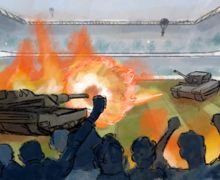Syracuse adapts tackling methods in age of targeting rule, concerns over player safety
Colin Davy | Staff Photographer
Several players said over the last two weeks that there is no one-size-fits-all way to bring a guy down, though one thing is clear: avoid helmet-to-helmet contact.
Devin M. Butler rattled off the commands: Key on the hip. Eye to the thigh. Wrap around. Shoulder through the thighs.
These are among the codes defensive coaches preach to tackle ball carriers and avoid a targeting call, a 15-yard penalty and automatic ejection. Outdated techniques, such as “bite the ball,” which is when a player’s facemask lands where the ball carrier is holding the football, puts the head and neck at risk.
Growing concerns over player safety have put tackling techniques in the spotlight. In 2013, the NCAA implemented the targeting rule, which can get a tackler tossed from the game for contacting a player above the shoulders or leading with the crown of the helmet. In 2015, the Big 12 began limiting its teams to one full-contact practice a week during the season. Last year, the Ivy League ceased full-contact practices altogether. This year, the NCAA banned two-a-day practices.
“You only get a finite number of days, finite amount of time to perfect the craft,” Butler said. “It makes you have a special attention to detail when you’re going through it.”
As the NCAA allows less practice time in pads to practice tackling, teams across the country are implementing new tactics. The subject draws particular attention to Syracuse (1-1), which returned more than 86 percent of its tackles from last season.

Jessica Sheldon | Staff Photographer
Senior linebackers Zaire Franklin and Parris Bennett combined for 211 tackles in 2016. But this year, Syracuse’s 109 tackles ranks 102nd in the country, and SU has struggled recently to keep defensive players healthy. Tackling can be risky, which amplifies why proper methods are a focal point.
Plus, offensive schemes like SU’s have spread the field, which means missed tackles have a greater chance of turning into touchdowns. Spread offenses also increase the number of plays per game and the duration of games, leaving players on the field longer and exposing them to more contact.
This weekend, Central Michigan senior lineman Mitch Stanitzek returns to the Carrier Dome for the first time since 2015. During that game CMU’s Nathan Ricketts was wrapping up SU quarterback Eric Dungey when Stanitzek dove and made helmet-to-helmet contact with him. Dungey completed the pass for a touchdown in the 30-27 overtime win, but he missed one game and Stanitzek was ejected for targeting.
Several players said over the last two weeks that there is no one-size-fits-all way to bring a guy down. Bigger bodies such as Franklin can hit higher because their larger chests and shoulders provide more room for error. Smaller defenders such as Kielan Whitner and Cordy must be more precise. All players agreed that their shoulder, not the helmet, should hit the ball carrier first.
“You get dynamic runners nowadays and they spin out of tackles,” Butler said. “If you get your head across the ball, you become susceptible because you have less body contact.”
Where exactly that shoulder should hit is not universal. Chest-high hits can be effective, but the head is more vulnerable. What to do after initial contact also varies by player and position.
Graduate transfer linebacker Austin Valdez was recruited to Bowling Green as a quarterback until, Valdez recalled, then-head coach Dino Babers said he was “too athletic” to not be on defense. Babers switched him to the other side of the ball where he learned a grassroots approach as a college sophomore. He performed basic tackling drills, which SU players said they do 15 minutes per day, to keep his head up and aim for the hips or below. In 2015, he was named to the All-Mid American Conference First Team.

Jessica Sheldon | Staff Photographer
Jordan Martin, a Toledo graduate transfer defensive back, said his primary focus is finding a low target angle to minimize unnecessary contact. From several yards out, Martin keys on where he wants to hit a player. He watches how the ball carrier is holding the ball and the direction of his hips. He knows carriers naturally lower their pads and brace themselves, so he is extra conscious in practice to get low and take away the legs. He wants to ultimately hit just below the waist.
“It’s so quick,” Martin said. “You have to line everything up correctly to avoid getting called for (it). You may be running, not trying to hit, and make contact in the wrong area and get called for targeting.”
Ravian Pierce, a junior college transfer tight end, said he has noticed that players are hitting him higher this year. In junior college, he was hit lower. He couldn’t pinpoint why, but the 6-foot-3, 237-pound junior thinks because he is harder to bring down, lower tackles can be effective. Now that he’s at a Power 5 school with stronger players, he said players can afford to hit him higher.
“Then you have those ‘for-sure tacklers,’” Pierce said. “Those guys that hold to anything and wait for the pack to get there. That’s what I would classify as a good tackle so that you don’t slip away.”
In high school, Whitner, a safety turned linebacker, was taught a rugby-style approach, putting his head on the back of the hip. Now, he stresses the importance of keeping leverage in the tackle. By that, he means to hit with the same shoulder and leg. His left shoulder should align with his left leg, for example. This keeps his head out of the tackle yet allows him to make forceful contact.
“You have to get your head on the back hip rather than across the guy to help cut down on concussions,” Whitner said, “and still be able to make a solid tackle.”
Published on September 14, 2017 at 9:24 pm
Contact Matthew: mguti100@syr.edu | @MatthewGut21





